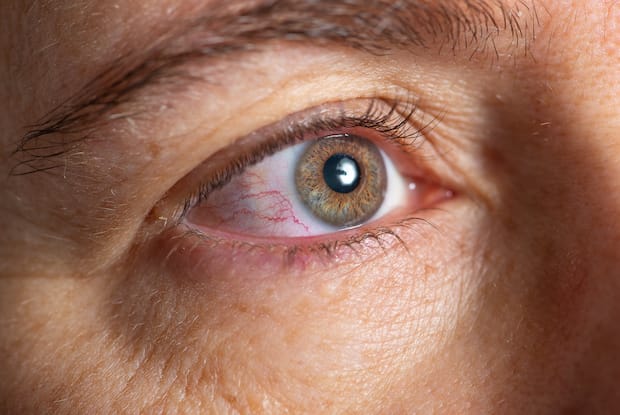Table of Contents
a. Viral and Bacterial Conjunctivitis
c. Conjunctivitis from Irritation
Overview
Pink eye is an eye disorder that is also known as conjunctivitis. It is very common in the United States and affects around six million people each year, mainly children. [1] Infectious Conjunctivitis is highly contagious and passes easily between people. If you think that you may have the condition, it is important to speak to a doctor so that it can be diagnosed. Early diagnosis and treatment help prevent this disorder from spreading. While pink eye may be irritating, it is unlikely that it will affect your vision. [2]
a. Pink Eye Symptoms
Conjunctivitis is an infection or inflammation of the clear membrane that covers the white area of the eyeball. The condition is known as pink eye because the primary symptom is a red or pink color appearing in the white part of the eye. Other common symptoms of pink eye include:
- Redness in one or both eyes
- Swelling of the eyelids
- Feeling like there is something in the eyes
- Itchiness or irritation in one or both eyes
- Tearing up
- Eye discharge that crusts over during the night, making it difficult to open your eyes
- Contact lenses feeling uncomfortable or not staying in place [3]
Keep reading to learn more about this condition, including the causes, types, symptoms, and mediations such as Zaditor (ketotifen) and Patanol (olopatadine).

Types of Conjunctivitis
The different forms of pink eye are based on its cause. Read below to learn about the differences between the conditions.
a. Viral and Bacterial Conjunctivitis
Both viral and bacterial conjunctivitis occur most frequently. [4] As the names suggest, these disorders are caused by viruses or bacteria developing in the body. Both viral and bacterial conjunctivitis are highly contagious and can be passed between people through hand to hand contact. [5]
Viral conjunctivitis is typically caused by the same virus that causes the common cold. It can also be caused by several other viruses, including herpes simplex virus (the cause of genital herpes and cold sores), varicella-zoster virus (chickenpox and shingles), and the coronavirus (a large family of viruses). [2] Viral pinkeye often develops in one eye first, causing tears and discharge before moving to both eyes. [6] This form of conjunctivitis may occur alongside cold or flu symptoms.
Bacterial conjunctivitis is caused by the same type of bacteria that causes strep throat and staph infections. [5] Bacterial pinkeye typically affects one eye, although it can affect both. As well as the above symptoms, bacterial conjunctivitis may also cause discharge, resulting in the eyelids sticking together. These symptoms may also occur alongside an ear infection. [3]
b. Allergic Conjunctivitis
Allergic conjunctivitis is caused by the body’s response to allergens, like pollen or animals. As your body responds to these allergens, they produce an antibody known as immunoglobin, which causes the release of histamines. Histamines then cause many signs of allergies, including eye redness. [2]
Unlike viral and bacterial pink eye, allergic conjunctivitis is not contagious. The condition may also cause other symptoms such as intense eye inflammation, itchy eyes, sneezing, or nasal discharge. Conjunctivitis can also occur when a chemical or irritant gets into your eyes. Common irritants include chlorine from a swimming pool, car fumes, and cigarette smoke. Typically, this form of pink eye occurs in both eyes and may cause intense itching, swelling, and tearing. [4] The main aim of treatment is to relieve symptoms. For all types of conjunctivitis, patients should stop wearing contact lenses and should dispose of any disposable contact lenses that have already been worn. Unfortunately, there is no treatment or cure for viral conjunctivitis. The symptoms will usually run its course and go away after seven to ten days. Using a warm compress on your eyes can help soothe your symptoms. As this type of pink eye is very contagious, you should avoid school or work until symptoms begin to improve. [5] Bacterial infections including conjunctivitis, are usually treated with antibiotics. Bacterial conjunctivitis should improve by itself within two weeks, but medications can help the condition improve within two to five days. While antibiotic eye drops are more suitable for adults, children may prefer to use an ointment. Common antibiotic eye drops include Cipro (ciprofloxacin) and Floxin (ofloxacin). [7] Eye drops may also be prescribed to treat allergic conjunctivitis. Common medications include Zaditor (ketotifen) and Patanol (olopatadine). Alternatively, your doctor may prescribe antihistamines to reduce and relieve all of your allergy symptoms. The content in this article is intended for informational purposes only. This website does not provide medical advice. In all circumstances, you should always seek the advice of your physician and/or other qualified health professionals(s) for drug, medical condition, or treatment advice. The content provided on this website is not a substitute for professional medical advice, diagnosis, or treatment.
c. Conjunctivitis from Irritation
How to Treat Pink Eye
a. Viral Conjunctivitis

b. Bacterial Conjunctivitis
c. Allergic Conjunctivitis
